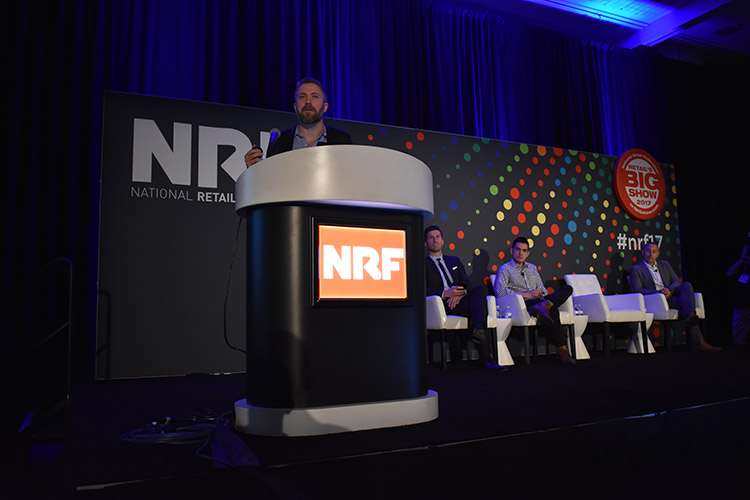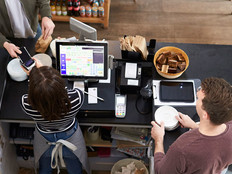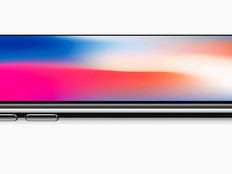NRF's BIG Show 2017: Retailers Need to Treat Mobility as a Unique Channel
For retailers, mobile commerce is not just about putting up a website and making it responsive so that it properly fits a smartphone screen. Retailers need to design mobile solutions with a specific purpose, and understand that customers use mobile to interact with brands in unique ways.
Those were some of the key takeaways from the panel on “Redefining Mobile” at NRF Retail’s BIG Show 2017 in New York City, which featured several retail executives who are pushing the boundaries
“Mobile is fundamentally changing the way people expect to interact with the world,” said Healey Cypher, CEO and founder of Oak Labs, a startup that is working with retailers to bring technology into physical stores for both customers and store associates, including an interactive digital mirror.
Cypher noted that, according to the Pew Research Center, 22 million Americans are dependent on mobile for broadband connectivity. Mobile technology is not just about getting customers to a retail store but engaging with them once they get there, he said. According to Internet Retailer, mobile commerce sales worldwide were on pace to hit $220 billion in 2016, a 53 percent increase from 2015.
Designing a Mobile Retail Experience
Jerry Hum, co-founder and CEO of Touch of Modern, an online retailer geared toward men that delivers curated roundups of products every day, said that creating a seamless mobile browsing and purchasing experience is very important for the company. User experience patterns on mobile are still being established, Hum said, which gives retailers “room to be creative and create an experience that is superior to others.”
Hum laid out his “mobile secrets” to success, the most important of which is to “find purpose before approaching” mobile. Mobile solutions are not for every retailer, and “you actually have to have a reason for the customer to download” a mobile app, he said.
Websites are akin to physical stores, in that a customers is visiting the retailer’s real estate. But apps are like being in someone’s home — retailers are visiting customers on their own turf.

Jamie Ovenden, director of digital and retail IT for the Arcadia Group, explains the importance of designing mobile solutions.
“In order to warrant that ask, you have to be able to facilitate an action that is repeatable,” such as delivering fresh content every day. Retailers need to determine if they have enough content that customers will want to consume repeatedly.
Retailers should also “prioritize one funnel” and not simply build mirror images of their websites, Hum said. Smartphones and tablets are small in screen size, and mobile solutions should be designed with one action in mind that can be accomplished with a finger swipe — like browsing, in the case of Touch of Modern.
There must also be a recognition of the differences between mobile and web users, as the app experience is more important than price to mobile users, Hum said.
Finally, mobile solutions need to be timely and take advantage of push notifications that smartphones and tablets afford. An email that someone reads at their desk while at work during the day is going to be less relevant and exciting that evening, Hum said. However, an app that sends out an alert based on a news event is timely and relevant. Hum noted that after the Chicago Cubs won the 2016 World Series, Touch of Modern sent out an alert about a baseball with a painting of Wrigley Field on it and sold out of the item quickly.
Design Mobile with the User Experience in Mind
People rarely leave their smartphones at home, and geolocation lets retailers create tailored mobile experiences. Jamie Ovenden, director of digital and retail IT for the Arcadia Group, which owns the global women’s fashion retailer Topshop, noted on the panel that the company can tell a lot by a user’s smartphone location.
Topshop knows what country a user is in, what language they are likely to speak and the currency they are likely to use. In the future, he said, the company hopes to use artificial intelligence and data analytics to infer a customer’s mood and intent.
Retailers need to create mobile experiences that mirror how customers are using their mobile devices, Ovenden said. He noted that 71 percent of Topshop’s UK customers visit the retailer’s website from a mobile device, and 51 percent of all customers do not start their visit on the company’s home page, meaning that retailers likely need to create more dynamic product pages.
Topshop also lets customers share selfies taken wearing the company’s clothing on its website and has created an experience via Instagram that lets users swipe to select “looks” they would like to purchase, akin to a dating app.
Going forward, Topshop wants to use mobile to deploy advanced messaging, chatbot-based service and omnichannel customer support. In the future, customers should be able to walk into a store, take out their phone and have the store know what they want to buy, he said. “We’re trying to use mobile to be the gateway to services” and interaction with the brand, he said.
Meanwhile, Chris Mason, CEO and co-founder of Branding Brand, which builds websites, apps and in-store tech for retailers, said that retailers need to think of the infrastructure that apps are connected to. That includes order management systems, customer service centers and loyalty programs.
According to Branding Brand, app users are 145 percent more valuable than mobile web users, and app sale conversions are 77 percent higher than the mobile web.
Apps provide retailers with “a chance to take engagement that people want to do on a casual basis.” This is the idea of “conversational commerce,” in which users are led through a series of prompts in a conversation that determines what they want to buy.
“The retailers that are going to win the future are providing that context, that bidirectional trend, asynchronous commerce,” Mason said.
Read articles and check out videos from BizTech’s coverage of NRF Retail’s BIG Show 2017 here.








